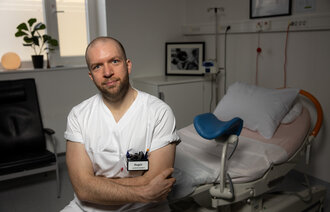Being a male nursing student. Male nursing students’ experiences in their first year of study.
Summary
Background: Studies show that male nursing students in Norway are twice as likely to drop out of their studies as female nursing students. Drop-out can be attributed to isolation, lack of role models, discrimination and insufficient support in their academic studies and clinical training. Nursing education and practice are strongly associated with qualities traditionally considered feminine, such as ‘care’, ‘empathy’ and ‘compassion’. These are traits that men may find it difficult to identify with. To reduce the drop-out rate in nursing education, we need to learn more about the experiences of male nursing students and what factors impact on whether they complete their studies.
Objective: We aimed to gather knowledge about the perceptions and experiences of male nursing students in their first year of study.
Method: The study employed a qualitative approach, and the empirical sample consisted of male nursing students. The students participated in two focus group interviews in the first semester of their first year of study. The data were analysed using Malterud’s systematic text condensation method. This study is part of a larger study following male students through their three-year bachelor’s degree in nursing.
Results: The study identified the barriers faced by male nursing students and examined how they dealt with these. To address the challenges of being in a female-dominated field of study, the men formed a ‘male fellowship’ that contributed to unity and a sense of belonging. The students valued male role models because their approach to and perspective of nursing differed from that of the female role models. The informants had little knowledge of what nursing entailed when they started their nursing education. Early exposure to practical procedures helped the students gain an insight into nursing practice. Skills training also helped them develop their nurse identity.
Conclusion: Nursing education is strongly associated with qualities traditionally considered feminine, which can make male nursing students feel alienated and disconnected. To encourage more men to study nursing and complete their studies, it is crucial that aspects traditionally associated with both masculinity and femininity are incorporated into the information about nursing education. The focus of the information should be on the competence and knowledge needed to qualify as a nurse.
Cite the article
Kambe M, Røthing M, Dahl H. Being a male nursing student. Male nursing students’ experiences in their first year of study.. Sykepleien Forskning. 2024;19(94433):e-94433. DOI: 10.4220/Sykepleienf.2024.94433en
Introduction
Male nursing students are twice as likely to drop out of their education as their female peers (1). In a female-dominated field of study, male nursing students encounter barriers that may lead them to drop out (2).
Nursing education and practice are strongly associated with qualities traditionally considered feminine, such as ‘care’, ‘empathy’ and ‘compassion’ (3). These are traits that men may not necessarily identify with. Drop-out can be attributed to social challenges, lack of role models, discrimination and insufficient support in academic studies and clinical training (1, 2).
To ensure that more men complete their nursing education, it is crucial to identify the barriers they encounter during their education and explore how educational institutions can facilitate an environment that is suitable for both male and female students.
In order to meet the demand for labour in the health and care sector, it is important to increase the number of male nursing students and the proportion of these who complete their education (4). In recent years, there has been a positive increase in the number of male applicants to nursing education, and almost 40 per cent more men are now working in the nursing profession than a decade ago (5). Despite this positive development, men still make up barely 10 per cent of the nursing workforce (6, 7).
Increasing the proportion of men in the nursing profession can provide male nursing students with role models they can more easily identify with, thereby making this field of study and profession more appealing to men (8, 9). In addition, gender-balanced workforces have been proven to be positive for the working environment. Male nurses can bring different perspectives in a female-dominated community (2, 10–12).
Research on gender and gender-segregated education shows that single-sex education can have an exclusionary effect that reinforces and perpetuates differences between the sexes (11, 13, 14).
We employed the theoretical model by Mackert (15) because it illustrates various social closure mechanisms related to occupations (16). The closure mechanisms in the model involve processes of setting boundaries, constructing identities and building societies where a monopoly is developed for one group at the exclusion of others (16).
The closure mechanisms are described at three levels: a structural level, an occupational/professional level and an organisational level. The structural level includes the context and social structure. The social structure involves, inter alia, gender mechanisms where women or men gain access to previously male- or female-dominated professions/occupations or education. Closure mechanisms at the occupational/professional level involve, for example, legitimacy and educational qualifications, where status groups are defined and shape the identity of the occupation/profession. The organisational level includes gender constructions, internalisation of sex-based differences in the profession and the relationships within the organisation. Barriers are reinforced through, for example, symbols and images used in the organisation (16).
In order to gain more knowledge about male nursing students, further research is needed on the challenges men face in nursing education and the changes needed in this education to retain male nursing students (2). There are several studies on this topic, but studies are needed that follow students over an extended period (17, 18).
Our study aimed to follow male nursing students throughout their three-year education and examine the barriers they encountered during this period. The study sheds light on the factors that impact on whether male students complete their nursing education.
Objective of the study
The objective of the study was to gain knowledge about the perceptions and experiences of male nursing students during their first year of study.
Research question: ‘What are male nursing students’ experiences in the first year of study?’
Method
The study has a qualitative research design involving two semi-structured focus group interviews. A longitudinal study will follow the informants throughout their three-year bachelor’s degree in nursing. The data in this article are based on focus group interviews held in the students’ first year of study.
We conducted interviews in focus groups to ensure a dynamic process between the participants and the researchers, enabling a broader exploration and description of the topic. The aim of the conversations with the male nursing students was to gain more knowledge and different perspectives on the topic. According to Malterud (19), conversations in focus group interviews enrich the dataset.
Data collection
The study was conducted in the first semester of the students’ first year of study. The informants did not have experience in clinical practice, but some had worked in the health sector. The informants were recruited from a cohort of 120 students, 18 of whom were men. The men were grouped together in two of four classes.
Before the study started, the project manager provided students with oral and written information about the study and invited male students to participate. The study was made up of a strategic sample of participants, as only those with experience in the relevant topic were invited to take part (20). The interviews were transcribed, anonymised and stored on the institution’s research server.
A phenomenological approach was used to capture the ‘lived experiences’ of male nursing students (21). The method is well-suited for participants sharing their views on and experiences with a common theme (22). We held two focus group interviews with six informants in each group (N = 12).
Analysis
The analysis was performed according to Malterud’s systematic text condensation (STC) (19), which is a tool used to summarise information from multiple informants. The analysis process consists of four steps, which can make large datasets more manageable (20).
The systematic steps in the analysis were as follows: 1) read through the entire dataset to form an overall impression of the transcribed text and identify preliminary themes; 2) identified and organised meaning units into codes, and the content of the codes was reduced to a condensate containing golden quotes; 3) systematically grouped the codes into the code groups established in step 2, and categories were created based on the meaning in the code groups; 4) synthesised the findings in each category into an analytical text with three main themes (19, 20).
Ethical considerations
The study (reference number 573191) was approved by the Norwegian Agency for Shared Services in Education and Research (Sikt). All transcribed text was anonymised. Participants were given information about the study, and informed consent was obtained from all participants. The informants could withdraw from the study at any point if they wished.
The informants and the moderator (a lecturer) were from the same institution as those conducting the study, which represents a potential study bias. It could also lead to informants’ responses being exaggerating or understated, which can weaken the validity of the study (19).
The informants in the study are male students, and they were interviewed by women. This may have impacted on the relationship dynamic and the understanding of the information conveyed by informants. Having a pre-existing relationship with the informants means that trust may already have been established, leading to a more seamless exchange in interviews. It is also beneficial when the interviewer is familiar with the specific academic setting and context in which the informants are providing information.
Results
The male nursing students in the study were young adults with professional experience from the care sector or industry.
The results from the analysis process are structured under the following themes: 1) Male nursing students’ perceptions of their study programme, and 2) Factors assumed to have a bearing on preventing drop-out.
Male nursing students’ perceptions of their study programme
Male pupils at upper secondary school have little knowledge of what qualifying as a nurse entails. The informants expressed that they were not familiar with a nurse’s duties or the opportunities for further studies. One informant said: ‘People don’t know what the options are. I hadn’t considered studying nursing because I had no idea how many options there were, such as specialising in intensive care or working offshore. Those things are very appealing, certainly to men’. (Informant 2)
The informants’ perception of the profession was that it mostly involved caring for and nursing patients, as well as tending to their personal hygiene needs. There was a clear perception that few male pupils at upper secondary school are equipped to make a decision about whether to pursue an education in health and care. Applying to study nursing required a certain level of personal development, which may explain why so few male pupils apply.
Several informants had tried out other fields of study and occupations before studying nursing. All agreed that the nursing profession is highly respected in Norway and is one of the best undergraduate programmes in the country. The curriculum covers a wide range of subjects and students have ample career options, which was an important criterion when choosing a study programme.
Nursing has traditionally been viewed as a female-dominated occupation, which can be perceived as a barrier for men. According to the informants, the older generation still expects doctors to be men and nurses to be women. Despite the stigma, the informants believed that the world is now less prejudiced in terms of gender roles and career choices.
Although one of the informants had received many positive responses to his choice of education, he said ‘I haven’t gone out my way to tell people that I’m studying nursing’. (Informant 5)
Factors assumed to have a bearing on preventing drop-out
Combining practical exercises and theory increased motivation, and introducing the nursing laboratory SimArena at an early stage made it easier for informants to identify with the role of nurse. The male nursing students highlighted the importance of quickly overcoming some barriers at the start of their studies, such as the proximity to patients and tending to their personal hygiene needs, in order to be comfortable in the role. After overcoming these barriers, the informants felt more confident in the nursing role and their choice of education. One informant said: ‘I’m now much more convinced than I was before that I’ve made the right choice. It’s partly because of the work we’ve done in the laboratory’. (Informant 5)
Practical exercises in SimArena were an important educational tool that helped the informants to understand nursing theory and practise procedures, and to prepare them for clinical practice. The informants found that the curriculum offered breadth and variation and that theory and practice were closely linked. They considered this to be positive.
The informants agreed that the community the men had formed during their studies was important. They referred to it as a ‘male fellowship’ and described how it created an atmosphere of camaraderie in the locker room before carrying out practical exercises in SimArena.
Being in a male environment was important for both well-being and learning. The male nursing students were divided into two classes, which they found beneficial as it was easier to find other men to work with in their class. One informant said: ‘It’s a bit easier to ask another bloke if he wants to study with me, than a woman; maybe they would think you were trying to hit on them?’. (Informant 10)
The male nursing students became more tightknit when working together in groups. The group relationship was crucial, both academically and socially; however, they believed that maintaining a balance between the sexes was essential, as men and women often have different points of view and can thus complement each other. Having a gender-balanced group fostered the sharing of different perspectives and experiences.
Although they found working with the opposite sex beneficial, they preferred to study with other men in their free time. It also emerged that gender was unimportant as long as the communication and chemistry between the students worked well.
Working in groups with men and women could be challenging at times. The women were often more stressed about what they needed to learn and work on than the men. The stress could quickly be transferred to the men, causing some of the male students to disengage. The fact that the men generally felt less stressed than the women throughout their studies sometimes made it difficult for them to work together.
One informant described what happened when they worked with the women: ‘I’m surrounded by a lot of women, they start stressing and that makes me stressed, then everyone gets stressed’. (Informant 4) They also found it difficult sometimes to integrate into a group of women and to sit beside them in the canteen.
The informants all agreed that it was easier to identify with lecturers of the same sex. The male lecturers had a different perspective from the female lecturers: ‘I think the lectures by male lecturers have been good, they bring a completely different perspective to our studies’. (Informant 4)
The informants found the male lecturers to be more direct and engaging. They wanted more male lecturers who could see the nursing profession from different perspectives.
Discussion
The discussion is organised into two main themes: 1) Male nursing students’ perceptions of their study programme, and 2) Factors assumed to have a bearing on preventing drop-out.
Male nursing students’ perceptions of their study programme
The findings in our study may suggest that the information provided to upper secondary school pupils and the general public about nursing education is insufficiently tailored to men. The informants in this study also expressed that they had little knowledge of the nursing profession beforehand. Ibáñez and García‐Mingo (16) describe how inadequate information about the various career options acts as a closure mechanism at the professional level. The lack of tailored information about nursing education means that male pupils are ill-equipped to decide whether to pursue an education they are only familiar with through traditional gender attitudes.
Additionally, the informants believed that male pupils at upper secondary school were not mature enough to make a decision about pursuing a career in the care profession. The information conveyed in the media and to upper secondary school pupils often revolves around care, nursing and attending to patients’ personal hygiene needs. The men may find it more appealing if the information instead focussed on the discipline and learning.
It was only at the start of their nursing education that the informants in our study received information about the curriculum content and all the options for further studies. Due to the range of options, the informants considered the nursing education to be one of the best undergraduate programmes in Norway.
Many of the male nursing students aimed to take further studies, which motivated their learning. This finding is supported by the study by Ellis and Meeker (23), which found that male nursing students planned to take further studies after completing their bachelor’s degree.
The approach to nursing education is almost completely devoid of masculinity due to deeply rooted historical gender attitudes. Nursing education possesses many feminine characteristics, which makes it challenging for men to identify with it. This leads to male nursing students having to establish their own identity within the nursing role.
The informants believed that there is now less prejudice in society with regard to gender roles and career choices. This may be an indication that traditional gender role patterns still exist, making it difficult to identify with the role of a nursing student. The traditionally feminine attitudes to the profession can act as a closure mechanism at organisational level (16).
To change the traditional gender attitudes to nursing education, there must be broader recognition within educational settings, healthcare institutions and society in general of men’s contribution to the nursing profession. This change must begin in educational institutions, where male students face barriers such as exclusion and gender-related prejudices (13).
Factors assumed to have a bearing on preventing drop-out
To create their own male identity as a nursing student, the informants felt it was important to be introduced to the nursing laboratory SimArena at an early stage. Using this tool helped them to understand what the nursing role entails. Primarily, they overcame personal barriers through, for example, activities that helped them understand how they felt about tending to patients’ personal hygiene needs and performing various procedures. The early introduction to SimArena also made them feel better prepared for clinical practice.
In a study by Henderson et al. (24), being prepared for clinical practice was regarded as a factor that contributed to students continuing their studies and prevented drop-out. Another study by Nedregård and Abrahamsen (1) revealed that the drop-out rate from nursing education is almost twice as high among male students as female students. There could be various reasons why men drop out of their studies, but the lack of male role models may impact on their motivation to complete their education (1).
The male nursing students in the study expressed how they found it easier to identify with lecturers of the same sex. Male lecturers brought different perspectives and points of view, which fostered curiosity and engagement and improved motivation. Having male role models created a supportive environment where the male nursing students could discuss their thoughts and concerns about the role of a nursing student (8, 13).
The lack of male role models in nursing education can be a barrier to male students developing a professional identity. According to Mackert (15), constructing a feminine identity model in an organisation can create a type of closure mechanism. In doing so, nursing education contributes to the prevailing gender imbalance as a result of male nursing students struggling to identify with the organisation, or the organisation excluding or overlooking male students (16). The absence of male role models in education can thus be a contributing factor to the drop-out rate among men in female-dominated fields of study (2).
At the organisational level, symbolism and imagery play a role in explaining and reinforcing the gender balance within a field (5, 16). Referring to nurses as ‘women’ in the nursing education can make male nursing students feel like a minority group and deepen their disconnect from the profession (13). Most nursing textbooks refer to nurses as ‘she’. The curriculum lacks references to men in the nursing role. This omission of men in the textbooks can contribute to male students feeling alienated and excluded (2).
Carnevale and Priode (13) suggest that using more gender-neutral language in lessons can create a more gender-inclusive environment (8, 13, 25). Although gender-specific language is used in nursing education, the male nursing students in the study felt there was little emphasis on gender among colleagues in clinical practice. To avoid prejudice against men in a female-dominated profession, the informants believed it is important for more men to pursue nursing, thus ensuring a better gender balance.
As a reaction to the female-dominated community in nursing education, the men in the study formed an informal network of male nursing students, known as the ‘male fellowship’. This was seen as a space where they could be themselves and discuss whatever they wanted without having to consider their female fellow students. Being a man in a female-dominated community can be a barrier to men’s autonomy and opportunities for self-expression (26).
The ‘male fellowship’ became an important arena for the informants, both academically and socially, and was formed as a reaction to the lack of belonging they felt as a student and as part of the organisation. Nevertheless, it is important for both female and male students to feel a sense of belonging to each other. Being part of a community and being able to identify with the organisation is important for students developing their own professional identity. This is supported by Ibáñez and García‐Mingo (16), who highlight the importance of students being part of the community and organisation and understanding their identity within these.
Regardless of the importance of forming a ‘male fellowship’, male nursing students feel they are viewed as a collective group rather than individuals (1, 3, 25). Not being recognised as an individual can hinder the development of an identity. This is an example of an organisational level where the culture has led to the development of various barriers (16).
Although the ‘male fellowship’ was important, the informants felt it was positive that the study group was made up of both sexes. They felt that the female students were more structured and more knowledgeable about the field, which they believed meant they learned more. The male nursing students, however, sometimes felt like a ‘disruptive element’ and that they had to adapt themselves both academically and socially to their female peers.
This finding is supported in the study by Kane et al. (3), where it emerged that male nursing students found it difficult to be accepted by their female peers. Being the only man in the study group could be challenging in terms of finding someone to study with. The findings highlight the importance of putting male students in the same class to create a sense of belonging among them (27). At the organisational level, this entails male students finding their identity and creating a sense of belonging to the organisation (16).
Conclusion
To meet the societal demand for nurses, more men need to apply for and complete a nursing education. Educational institutions have a responsibility to adapt the curriculum to both male and female students. The current nursing curriculum is largely characterised by femininity, which can make male nursing students feel alienated and disconnected.
Concepts such as ‘compassion’, ‘care’ and ‘empathy’ pervade the education and the information conveyed about it. These concepts may not necessarily appeal to men and should be replaced by more information about what skills, competencies and knowledge are required to qualify as a nurse.
Further research should focus on how educational institutions and society, through the information they provide, can value and accommodate both feminine and masculine characteristics in nursing education and professional practice. Additionally, studies should be conducted that follow male nursing students over an extended period to identify factors that promote and hinder their academic progression.
The authors declare no conflicts of interest.
Open access CC BY 4.0
The Study's Contribution of New Knowledge







Comments